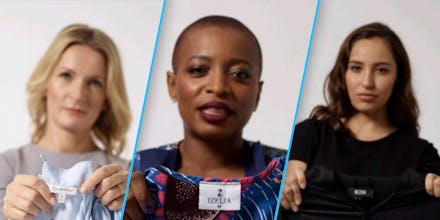The empowering reason why women in the UK have started sharing their clothing sizes

While many eyes at London Fashion Week were focused on those bejeweled Crocs and the dancing fruits at the Charlotte Olympia show, some women in the U.K. were busy taking a stand against the wild variations in women's clothing sizes, in an effort to challenge the fashion industry's proclivity for just one body type.
How? By sharing their clothing sizes on social media.
In a hashtag campaign launched by the U.K.'s Women's Equality Party, the political organization has asked women to share a picture of their size tags with the hashtag #NoSizeFitsAll.
"1 in 5 women in the U.K. cut the label out of their clothes, with 70% stating they do so out of shame and embarrassment at their sizes," WEP wrote on its Instagram.
So while women of various different shapes and sizes share their, well, sizes, the campaign hopes to illustrate the fact that it is completely OK and normal to be different sizes in different brands and styles. No one size can fit all women, and no one size can always fit you. In one store, you may be a 10, in another, a 6. And that's completely OK.
It's an idea that's been echoed in the United States as well, with women and men going viral after showing off the extreme variation between stores when it comes to sizes and fit. For example, in May, Benjamin Ashton Cooper went viral after showing off just how small his girlfriend's clothes were, despite being labeled with an "XL."
"I noticed that a lot of what she was getting rid of was of the XL size," he wrote in a Facebook post. "That didn't look right to me, and here's why: They fit me."
So far, women have started using WEP's hashtag on Twitter and Instagram, showing off sweaters and pants of various different sizes, as if to say, "You're not alone."
"My fav PJ top is [size small]. Meanwhile, my fav bottoms are [size large]," one woman wrote on Twitter.
"I'm a size 10, 12 and 14," another woman wrote on Instagram, to which another woman responded, "I am also 10 / 12 / 14 depending on the brand and the cut. Helps me to not define myself as a number [or] size."
Those tiny tags can hold a lot of meaning. A 2014 study found that the size a woman wore could directly affect her self-esteem. "Smaller sizes were found to have a positive effect on body image, particularly for younger women," Tammy R. Kinley, an associate professor at the University of North Texas, wrote. "Larger subjects felt more positive about their bodies when they achieved fit in a smaller size."
And over in the U.K., the WEP reports that "eating disorders affect 1.6 million people in the UK, 89% of whom are female."
In addition to the campaign, WEP is also campaigning for the British Fashion Council, which organizes London Fashion Week, to enforce a rule that would make fashion designers show at least two different sample sizes, one of which should should be a U.K. size 12 or above, which translates to a U.S. 10.
It's also asking for U.K.-based fashion publications to include at least one woman who is a U.K. size 12 or above in one fashion spread a month.
London Fashion Week has wrapped up, but women in the U.K. clearly aren't done talking about how powerful fashion can be.